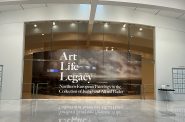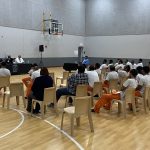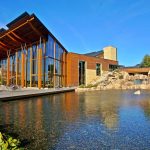A conversation with Thomas Wright
As America’s most productive and famed architect of the 20th century, Frank Lloyd Wright’s style is pervasive, not only in the American Midwest, but has a recognizable presence all over the world. Wright is most well-known for developing organic architecture, a building philosophy aimed at cultivating counterbalance between interior and exterior spaces, harnessing and responding to nature to allow for comfort and beauty in work and living habitats.
Thomas Wright, grandson of the architect, came to Milwaukee to speak at an environmental conference about his experience of “living green” in a Frank Lloyd Wright home, specifically the house in Bethesda that was built for his parents, where he now resides with his wife, Etsuko. Wright visited the Milwaukee Art Museum on Friday to take in the exhibition of his grandfather’s work, and to share with visitors some of his fond memories of time spent at Taliesin East.
Much like Frank Lloyd Wright himself, Taliesin has had a storied, mythic existence. In its lifespan it saw many international students, concerts of visiting musicians, harvests, two devastating fires, gruesome murders, and has been re-built twice.
Taliesin East, the home, school and farm compound in Spring Green, Wisconsin, was the site where Frank Lloyd Wright and his many apprentices put into practice the tenets of organicism, striving towards self-sufficiency in an idyllic domestic sphere. When they arrived, apprentices were hardly prepared for the tasks that were requisite in their “architecture” education, including domestic duties like churning butter and harvesting crops.
The weekends, according to Wright’s recollection, were an oasis of culture and art. His grandfather had a voracious appetite for the arts, particularly music.
Thomas Wright shared memories of a medieval choral ensemble (in which he participated), chamber orchestral performances, elaborate international dinners, harp music, and film screenings in the home theater: an assemblage of activities that were in stark contrast to the salt-of-the-earth farm life and work that occupied the hours of the week.
At the peak of its function as a training ground for architects, the few summers that Thomas Wright spent at Taliesin would be the most intimate experiences he was ever to have with his grandiose and distant grandfather.
The first time I personally saw an image of Frank Lloyd Wright, it was an oil portrait slide in an art history lecture. In it, the man stands be-caped and be-capped, leaning on a cane atop a mound in front of the rolling hills of bucolic Wisconsin, in a stance of virtual dominion.
“My vision of my grandfather is exactly like the portrait,” Wright told me before his talk.
“I’d see him taking clients and visitors around. I’d see him with his cape, with his porkpie hat and his cane, which he definitely did not need…but he used the cane in two ways. One, to point out things, and secondly, as a sort of weapon to use against those who disagreed with him,” he said, chuckling.
As we spoke in the lecture hall of the museum, I asked Wright what he thought his grandfather would think of the Calatrava, Milwaukee’s most prominent architectural thumbprint.

A Usonian home, exploded and suspended to show its parts and systems. TCD photo by Nickolas Nikolic.
“I think he would like it. If he walked into this building or even saw it from the outside, he would initially have some negative comments. He hardly accepted anything that he didn’t do himself.”
“The truth against the world” was the mantra with which Frank Lloyd Wright was raised by his Welsh stead. His truths and his style were asserted boldly, unapologetically in his life and in his works. And yet, Thomas Wright does not seem descendant from this particular strain of dogma. He laughs easily, comes across as intelligent, practical, economically articulate, and kind. In contrast to his infamously impractical and ambitious grandfather, Thomas has made a career as a volcanist, professor and government employee.
He shared with the audience at the Museum amusing, vivid impressions of the scenes he experienced at Taliesin, including the shuffling fleet of fancy cars, the grand dinners, evening harp performances, spontaneous dinner lectures from his grandfather, and the challenges of farm work. It was clear that such experiences at Taliesin had a great impact on his life, not because of the time he was able to share with his grandfather there, but rather because of incredible, historical significance and energy of of the place itself.
When museum director Daniel Keegan pressed Thomas Wright to say more about his relationship with his grandfather, he answered honestly.
“Even though I stayed in the family quarters, I think I shook his hand once…I never had what I consider any sort of family contact with him.”
Though they were not close, Thomas has closely read and become an interpreter of the philosophies of his grandfather’s approach to design. He describes the poetic language that his grandfather used to communicate the principles of organicism as “incomprehensible.” He gave the audience a bullet-point list of practical examples illustrating what his grandfather meant when he said that buildings should “grow like seeds.”
From the way his homes make use of trees and the sun, selectively blocking the generous summer rays and harnessing the winter light angles, to the curved walls, cozy bed chambers and signature hearths at the center of homes, Frank Lloyd Wright’s designs are conducive to pleasure and shared comforts and connection to the environment, and seem reverential of the experience of family life in a given landscape.
“(Frank Lloyd Wright’s) emphasis was on beauty,” says Thomas. “The way he created beauty was to integrate the buildings with their natural surroundings, and use elements in his architecture that made people feel comfortable.”
Nothing could stop the productivity of Frank Lloyd Wright. Sometimes at the expense of practicality, intimacy or consistency for his relations, he boldly produced, philosophized and imagined on a spectacular, almost inhuman scale. In his life he married three times and had seven children. He was compelled to rebuild Taliesin though it burned down twice. Even the mass murder (which claimed his second wife) did not deter him from pursuing his ambitions for the compound.
“An artist’s limitations are his best friend,” Frank Lloyd Wright stated at one point in his career. Perhaps adversity only registered to him as an opportunity to refine his goals; perhaps the limitations of his own personality allowed for the degree of freedom and self-reliance necessary to produce relentlessly, to constantly move forward and imagine.
I asked Thomas if his grandfather was at all superstitious, given the compound’s ominous history. Taliesin, a Welsh word translated as “shining brow,” was aptly (and coincidentally) also the name of a Welsh poet, a magician and priest.
“(Frank Lloyd Wright) welcomed fire. He never carried any insurance because he believed through renewal, there is a chance to reinvent. He never regretted anything that happened.”
Frank Lloyd Wright : Organic Architecture for the 21st Century is on display at the Milwaukee Art Museum through May 15, 2011. For more information, click here.
Art
-
Exhibit Tells Story of Vietnam War Resistors in the Military
 Mar 29th, 2024 by Bill Christofferson
Mar 29th, 2024 by Bill Christofferson
-
See Art Museum’s New Exhibit, ‘Portrait of the Collector’
 Sep 28th, 2023 by Sophie Bolich
Sep 28th, 2023 by Sophie Bolich
-
100 Years Of Memorable Photography
 Sep 18th, 2023 by Rose Balistreri
Sep 18th, 2023 by Rose Balistreri


















Super job, Elisabeth. Thanks. — tom
sorters massage…
[…]b Thanks for every one of your hard work on this web page. My niece really lo 2o[…]…